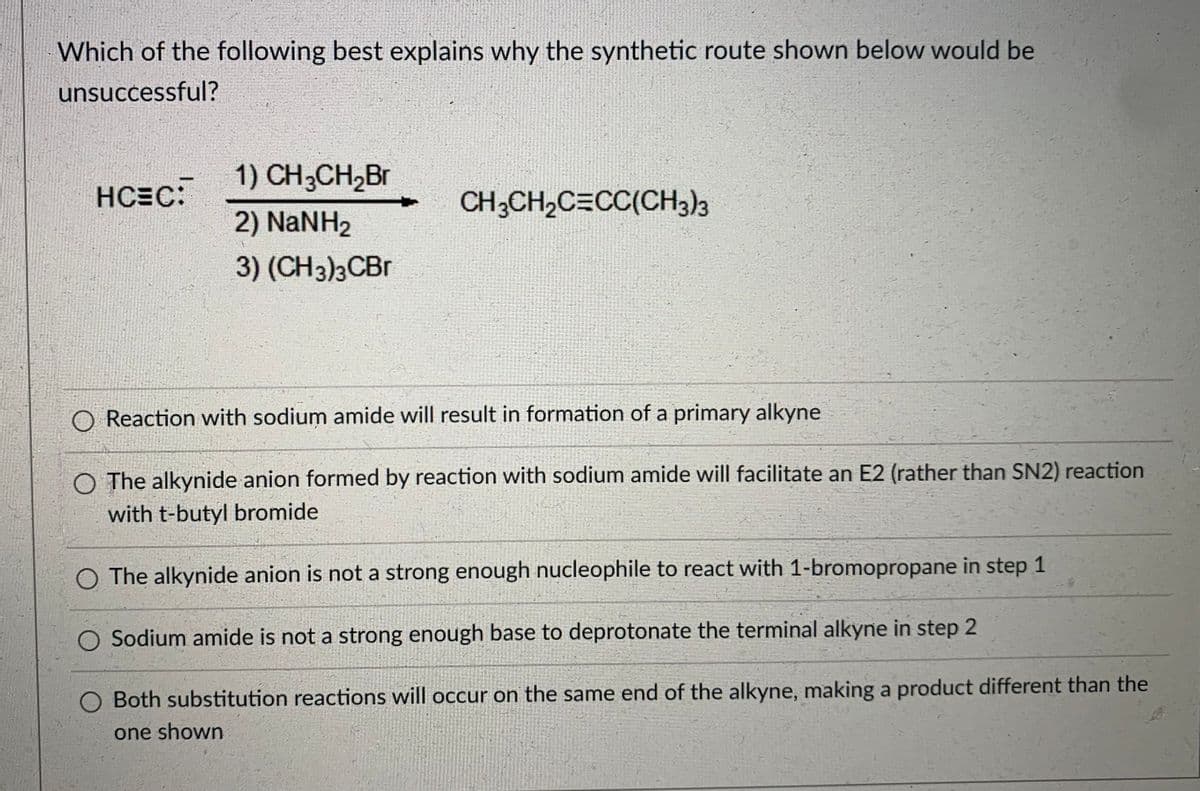Which of the following best explains why the synthetic route shown below would be unsuccessful? 1) CH;CH,Br HCEC: CH;CH,C=CC(CH3)a 2) NANH2 3) (CH3)3CBr O Reaction with sodium amide will result in formation of a primary alkyne O The alkynide anion formed by reaction with sodium amide will facilitate an E2 (rather than SN2) reaction with t-butyl bromide O The alkynide anion is not a strong enough nucleophile to react with 1-bromopropane in step 1 Sodium amide is not a strong enough base to deprotonate the terminal alkyne in step 2 O Both substitution reactions will occur on the same end of the alkyne, making a product different than the one shown
Which of the following best explains why the synthetic route shown below would be unsuccessful? 1) CH;CH,Br HCEC: CH;CH,C=CC(CH3)a 2) NANH2 3) (CH3)3CBr O Reaction with sodium amide will result in formation of a primary alkyne O The alkynide anion formed by reaction with sodium amide will facilitate an E2 (rather than SN2) reaction with t-butyl bromide O The alkynide anion is not a strong enough nucleophile to react with 1-bromopropane in step 1 Sodium amide is not a strong enough base to deprotonate the terminal alkyne in step 2 O Both substitution reactions will occur on the same end of the alkyne, making a product different than the one shown
Organic Chemistry
8th Edition
ISBN:9781305580350
Author:William H. Brown, Brent L. Iverson, Eric Anslyn, Christopher S. Foote
Publisher:William H. Brown, Brent L. Iverson, Eric Anslyn, Christopher S. Foote
Chapter11: Ethers, Epoxides, And Sulfides
Section11.9: Reactions Of Epoxides
Problem DQ
Related questions
Question

Transcribed Image Text:Which of the following best explains why the synthetic route shown below would be
unsuccessful?
1) CH;CH2Br
HCEC:
CH3CH2C=CC(CH3)3
2) NaNH2
3) (CH3)3CBR
O Reaction with sodium amide will result in formation of a primary alkyne
O The alkynide anion formed by reaction with sodium amide will facilitate an E2 (rather than SN2) reaction
with t-butyl bromide
O The alkynide anion is not a strong enough nucleophile to react with 1-bromopropane in step 1
O Sodium amide is not a strong enough base to deprotonate the terminal alkyne in step 2
O Both substitution reactions will occur on the same end of the alkyne, making a product different than the
one shown
Expert Solution
This question has been solved!
Explore an expertly crafted, step-by-step solution for a thorough understanding of key concepts.
This is a popular solution!
Trending now
This is a popular solution!
Step by step
Solved in 2 steps with 1 images

Knowledge Booster
Learn more about
Need a deep-dive on the concept behind this application? Look no further. Learn more about this topic, chemistry and related others by exploring similar questions and additional content below.Recommended textbooks for you

Organic Chemistry
Chemistry
ISBN:
9781305580350
Author:
William H. Brown, Brent L. Iverson, Eric Anslyn, Christopher S. Foote
Publisher:
Cengage Learning

Organic Chemistry: A Guided Inquiry
Chemistry
ISBN:
9780618974122
Author:
Andrei Straumanis
Publisher:
Cengage Learning


Organic Chemistry
Chemistry
ISBN:
9781305580350
Author:
William H. Brown, Brent L. Iverson, Eric Anslyn, Christopher S. Foote
Publisher:
Cengage Learning

Organic Chemistry: A Guided Inquiry
Chemistry
ISBN:
9780618974122
Author:
Andrei Straumanis
Publisher:
Cengage Learning
